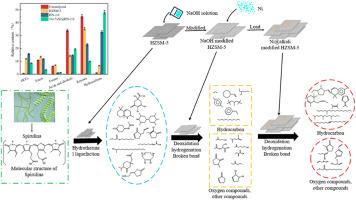Ni @碱改性HZSM-5在微波辅助两段水热液化中协同催化升级螺旋藻生物油
IF 6.2
2区 工程技术
Q2 ENERGY & FUELS
引用次数: 0
摘要
解决全球能源短缺和环境污染的迫切需要加速了可再生藻类生物油的开发。螺旋藻具有固碳率高、不与耕地竞争、富含蛋白质脂质的特点,是水热液化(HTL)的理想原料。然而,螺旋藻衍生的生物油通常存在高氧含量和低热值的问题。为了克服这些限制,本研究开发了一种微波辅助的两阶段HTL工艺,并集成了负载ni的碱改性HZSM-5催化剂。与传统催化剂依赖昂贵的贵金属或在微孔结构中受扩散限制不同,该系统在分层结构的沸石上使用地球上丰富的镍,以提高成本效益和催化效率。用NaOH处理HZSM-5产生介孔,然后用Ni浸渍引入氢化官能。系统地研究了NaOH浓度和Ni负载对催化剂性能的影响。以3%硫酸为培养基,采用响应面法对工艺进行优化,并采用GC/MS对生物油成分进行分析。用1 mol/L NaOH进行改性,将烃含量提高到32.9%,随后用5 wt%的Ni进行负载,将收率协同提高到48.1%。分子动力学模拟为螺旋藻衍生模型化合物在亚临界水中的键裂解和转化途径提供了机制见解。与现有的催化体系相比,本研究显著提高了生物燃料的质量,为螺旋藻生产高质量生物油提供了有效的催化策略和基础见解。本文章由计算机程序翻译,如有差异,请以英文原文为准。

Synergistic catalytic upgrading of spirulina bio-oil via Ni @ alkali-modified HZSM-5 in microwave-assisted two-stage hydrothermal liquefaction
The urgent need to address global energy shortages and environmental pollution has accelerated the development of renewable algal bio-oils. Spirulina stands out as an ideal feedstock for hydrothermal liquefaction (HTL) owing to its high carbon sequestration rate, non-competition with arable land, and rich protein-lipid content. However, Spirulina-derived bio-oil typically suffers from high oxygen content and low heating value. To overcome these limitations, this study developed a microwave-assisted two-stage HTL process integrated with a Ni-loaded, alkali-modified HZSM-5 catalyst. Unlike conventional catalysts that often rely on costly noble metals or suffer from diffusion limitations in microporous structures, this system employs earth-abundant nickel on a hierarchically structured zeolite to enhance both cost-effectiveness and catalytic efficiency. HZSM-5 was treated with NaOH to create mesoporosity, followed by Ni impregnation to introduce hydrogenation functionality. The effects of NaOH concentration and Ni loading on catalyst properties were systematically investigated. Process optimization was performed via response surface methodology using a 3 % sulfuric acid medium, and bio-oil composition was analyzed by GC/MS. Modification with 1 mol/L NaOH increased hydrocarbon content to 32.9 %, while subsequent loading with 5 wt% Ni synergistically boosted the yield to 48.1 %. Molecular dynamics simulations provided mechanistic insights into bond cleavage and conversion pathways of Spirulina-derived model compounds in subcritical water. Compared with existing catalytic systems, this study significantly improves the quality of biofuels, providing an efficient catalytic strategy and fundamental insights for the production of high-quality bio-oil from spirulina.
求助全文
通过发布文献求助,成功后即可免费获取论文全文。
去求助
来源期刊

Journal of The Energy Institute
工程技术-能源与燃料
CiteScore
10.60
自引率
5.30%
发文量
166
审稿时长
16 days
期刊介绍:
The Journal of the Energy Institute provides peer reviewed coverage of original high quality research on energy, engineering and technology.The coverage is broad and the main areas of interest include:
Combustion engineering and associated technologies; process heating; power generation; engines and propulsion; emissions and environmental pollution control; clean coal technologies; carbon abatement technologies
Emissions and environmental pollution control; safety and hazards;
Clean coal technologies; carbon abatement technologies, including carbon capture and storage, CCS;
Petroleum engineering and fuel quality, including storage and transport
Alternative energy sources; biomass utilisation and biomass conversion technologies; energy from waste, incineration and recycling
Energy conversion, energy recovery and energy efficiency; space heating, fuel cells, heat pumps and cooling systems
Energy storage
The journal''s coverage reflects changes in energy technology that result from the transition to more efficient energy production and end use together with reduced carbon emission.
 求助内容:
求助内容: 应助结果提醒方式:
应助结果提醒方式:


